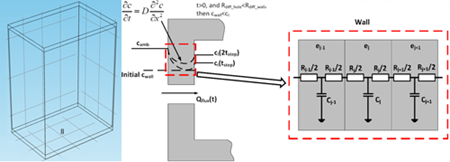Modeling of the entire local climate directly using numerical modeling is too comprehensive if the goal is producing fast models which are applicable for multi-dimensional design optimization in industrial practice (need for over-night optimization). Therefore, building semi-empirical models based on a proper description of the governing physics (coupled heat and mass transport) and calibrated towards empirical data is more promising. Such semi-empirical models combined with validated empirical data have a substantial potential for cost and time in predicting the internal climate profile in enclosures via computerized experiments. Thus, the total time used for product development and test phases can be essentially minimized.
Modelling work include numerical models and equivalent RC circuits, which are developed and validated against experimental data.